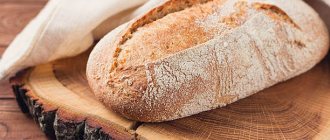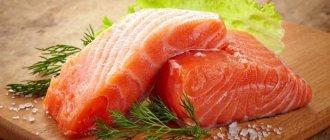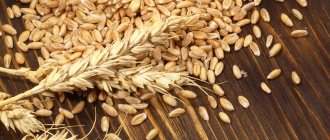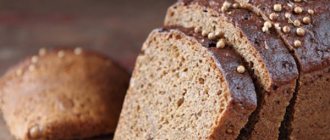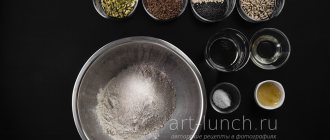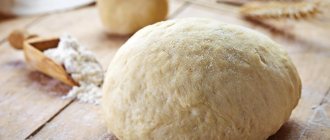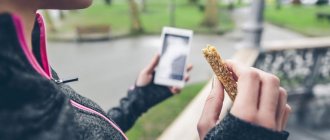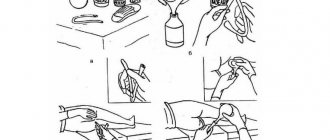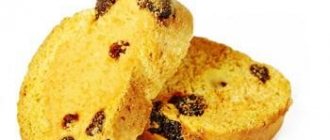Caucasian lavash, Indian chapati, Mexican tortilla, Jewish matzo and Russian flatbread. How great is the variety of unleavened bread among different nations. The tradition of baking yeast-free bread dates back to the times of ancient Egypt, but this product is still popular today. Soda bread is also called Irish because it was poor Irish housewives who baked it every day to feed their families. And the festive table was served with freshly baked soda cake with the addition of herbs, berries, and sugar.
Today we will teach you how to cook soda bread according to ancient and modern recipes with the addition of various ingredients.
Yeast-free bread: benefits and harms of the product
Experts say that with frequent consumption of fermented products, the human body begins to suffer from rapid fatigue. His susceptibility to adverse environmental influences increases. In other words, lovers of lush and ruddy products very often have decreased immunity, which contributes to rapid illness. Therefore, among all homemade baked goods, yeast-free bread is the safest. The benefits and harms of this product are the main topic of discussion for many experts.
Store-bought yeast-free bread does not actually contain baker's yeast. But to obtain fluffy baked goods, manufacturers add special yeast cultures or so-called wild yeast.
Very often, to obtain such bread, they use dough obtained by processing hop cones or willow twigs. However, researchers claim that wild yeast is no different from regular baker's yeast.
So what is the difference between yeast and yeast-free bread? The benefits and harms of these products are absolutely the same. In this regard, experienced chefs recommend preparing real yeast-free bread, making it without any kind of yeast (including hop cones and willow twigs), and using only unleavened dough.
Irish soda bread: history, properties, recipes
Soda bread is very popular in many countries as it does not take much time to prepare. This bread is especially widely used in Ireland.
Benefits and harms
Yeast-free baked goods are a safe food product that does not harm the body. But only homemade baking has this property.
Yeast-free store-bought bread also does not contain yeast, but some yeast cultures (in other words, wild yeast) are still present in it, since it is necessary for the product to be fluffy. Therefore, to obtain real soda bread, only unleavened dough is used.
So what are the pros and cons of Irish bread? The beneficial qualities of bread include:
- Irish bread with soda made from wholemeal flour promotes rapid weight loss;
- bread contains a large amount of fiber, vitamins, proteins, carbohydrates;
- helps improve the functioning of the digestive system.
The downside of Irish bread is that if consumed in excess, acid processes in the body are disrupted. In addition, people who are overweight should eat bread with caution - if consumed excessively, the opposite effect may occur, the weight will not decrease, but increase.
Irish bread spoils quickly, so it is best to eat it the same day.
Irish bread - background
The traditional recipe for Irish soda bread was created by poor people who baked it daily. The minimum preparation time and the ingredients used made it the most popular food product in poor families. On holidays, some cherries, sugar or herbs were added to the bread.
Housewives in Ireland made cross-shaped cuts on it before placing bread in the oven. There was a belief that such an amulet drove away evil spirits from family members. But some historians believe that such significance was not immediately attached to the incision. At first, a cut was made on the bread so that after baking it could be easily divided into pieces.
Round bread is most often baked in the southern regions of Ireland. In the north of the country, soda bread was made in the form of a disk, which was cut crosswise into 4 parts and fried in a frying pan. In the poorest families, who had neither an oven nor a frying pan, housewives baked bread in cast iron pots, which were suspended over burning peat.
Irish soda bread in a slow cooker
A huge number of soda bread recipes have already been developed for cooking in a slow cooker.
We will need the following components:
- flour (preferably coarse) - 2 cups;
- oat flakes - 1 tablespoon;
- sugar - 1 teaspoon;
- salt - 1 teaspoon (without a slide);
- butter - 50 grams;
- kefir - 1 glass;
- soda - 1.5 level teaspoons;
- nuts, seeds - optional.
First, in a deep bowl, combine all the dry ingredients - cereal, flour, sugar, salt, soda, stir well. Soften the butter and add to a bowl, pour in the kefir. Then knead the dough. There is no need to knead for a long time; the dough should become soft.
Grease the multicooker bowl with butter. The dough is distributed in an even layer in the bowl; cuts can be made on top of the bread. Set the multicooker to the “Baking” mode and bake the bread for 35 minutes.
At the end of the process, the bread is pulled out, the crust is greased with butter and wrapped in a towel. As soon as the bread has cooled, you can eat it.
Irish soda bread with currants
Another interesting recipe for making soda bread is with currants. Required:
- flour - 3 cups;
- kefir - 1 ¾ cups;
- sugar - 2/3 cup;
- butter - 2 tablespoons;
- baking powder - 3 teaspoons;
- currants - ¾ cup;
- salt - 1 level teaspoon;
- soda - 1 teaspoon (without a slide);
- egg - 2 pcs.
Sift the flour through a sieve, add baking powder, salt, sugar, soda; add currants. Melt the butter, beat the eggs and add to the flour. Then pour in kefir. Knead the dough. The consistency of the dough should resemble biscuit.
Grease the mold with butter and distribute the finished dough in it. Heat the oven to 180°C and bake the bread in it for an hour. There is no need to immediately remove the finished bread from the mold; it is necessary that it cools completely.
Irish Soda Bread by Darina Allen
Darina Allen offered her own version of soda bread, the recipe for which is quite simple. To prepare it you need:
- whole wheat flour - 1 1/3 cups;
- plain flour - 2/3 cup;
- salt - 1 teaspoon, without a slide;
- baking soda - 1 teaspoon, without a slide;
- egg - 1 pc.;
- vegetable oil (sunflower or other) - 1 tablespoon;
- honey, molasses or brown sugar - 1 tablespoon;
- buttermilk - 1 2/3 cups, add as needed;
- sunflower seeds, sesame seeds - optional.
First you need to preheat the oven to 200°C.
Sift the flour, add salt and soda to it. Lightly beat the egg and mix with flour. Then add the remaining ingredients - honey, buttermilk, butter. Knead the dough thoroughly. If the dough is too stiff, add more buttermilk until the dough becomes soft. The finished dough will slightly stick to your hands.
The mold is greased with oil and the dough is distributed in it. The top of the bread is sprinkled with seeds or sesame seeds. Bake for 45-60 minutes; you can check the readiness of the bread with a toothpick. Before serving, cool the bread to room temperature on a wire rack.
Cooking tips
- First, mix the dry ingredients of the dough, and only then add the liquid ones.
- If you plan to bake bread in a bread machine, then the ingredients should be added in the sequence specified by the bread machine model.
- Buttermilk can be replaced with kefir or cream.
- The oven is always heated to 180-200°C.
- If the crust of the bread turns out to be hard, then grease it with butter.
- The bread is served slightly warm or cold.
- The shape can be any - round, rectangular or loaf-shaped.
- You can add nuts, seeds, sesame, flax seed, coriander or dried fruits to the recipe.
sodaved.com
Making yeast-free bread at home
As mentioned above, true yeast-free bread should be prepared without the use of any type of yeast. Therefore, we decided to use whole grain flour to leaven such baked goods. But first things first.
So, to make homemade yeast-free bread yourself, we will need:
- quick rolled oats - 1 full glass;
- whole grain flour - 1 full glass;
- table soda - half dessert spoon (optional);
- table salt - ½ small spoon;
- liquid honey – 2 large spoons;
- sunflower oil (take without flavor) – large spoon;
- warm fat milk – 1.6 cups.
Preparing dough with rolled oats
Before baking yeast-free bread, you need to knead the base. To do this, warm fat milk is poured into a deep container, and then combined with a spoonful of honey and whole grain flour. Both ingredients are mixed until the consistency of thick sour cream, covered with a towel and left in a warm place (about 5 hours, but longer). During this time, the flour mass should ferment a little. If this doesn't happen, then it's okay. To obtain fluffy baked goods, you can add baking soda to it.
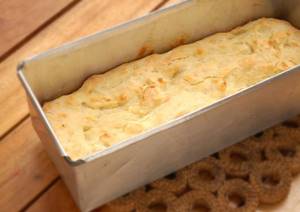
Thus, after keeping the ingredients warm, add rolled oats crushed in a coffee grinder, the remains of liquid honey, sunflower oil and table salt. By mixing the ingredients, you get a fairly stiff but soft dough. It is immediately used for its intended purpose.
Reviews
Yeast-free bread contains many more useful elements. It is a rich source of energy. At the same time, we must not forget that it never ousted traditional yeast products from the shelves.
It is noteworthy that some people attribute small size to the disadvantages of a yeast-free product. So, if a person sees a large bread on the counter, and next to it a product that is half the size, the psychological effect will be such that he will reach for a larger product.
In addition, not everyone is accustomed to the taste of sourdough bread. Most often, such a product is dense and hard. If a person has dental problems, he is unlikely to choose such bread.
For manufacturers themselves, there are difficulties at the stage of sourdough bread production. After all, it needs more time to ripen than options with yeast. Of course, this does not detract from the final value of the product. However, making bread with yeast, where you just stir the powder and then wait and bake, is a more cost-effective process.
However, yeast-free bread continues to be actively produced, and it can be found, if not on all, then on very many shelves.
Serving homemade bread to the table
Homemade bread without the use of baker's or any other yeast is much tastier than what is sold in the store. Moreover, such baking is much healthier. After all, scientists have long proven that yeast fungi, which are used to make bread and other products, contribute to the appearance and development of cancer cells. Therefore, we recommend baking bread exclusively at home.
This product can be served either hot or already cooled. As a rule, bread with rolled oats and honey is presented to guests along with the first or second courses.
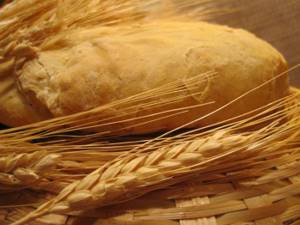
Preparing yeast-free bread with kefir
Fermented milk drink can serve as an excellent starter for making homemade bread. It’s not without reason that this product is often used for baking various buns, pancakes and other sweets.
So, to make real yeast-free bread at home, you need to purchase in advance:
- whole grain flour - about 450 g;
- baking soda - dessert spoon;
- table salt - dessert spoon;
- fresh high-fat kefir – about 420 ml;
- sesame seeds – 2 large spoons;
- small egg – 1 pc.;
- pumpkin seeds - 2 large spoons.
Preparing the base
Yeast-free bread with kefir is prepared much faster than the previous one. After all, to knead the base, there is no need to keep the dough in a warm place for a long time.
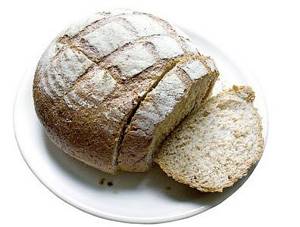
To prepare homemade bread, fresh high-fat kefir is poured into a metal container and heated slightly over low heat. After this, the fermented milk drink is removed from the stove and the table soda is quenched in it. When the product stops foaming, add table salt, sesame and pumpkin seeds, as well as whole grain flour. All ingredients are mixed until a homogeneous and soft dough is obtained. Cover it with a napkin and leave it aside for 15-19 minutes.
Spreading
The popularity of this type of bread is steadily growing. In fact, there is a second wave of popularity. After all, since ancient times, when baked goods were prepared for the first time, they were like this. Yeast did not yet exist in those days. At the moment, the return to this ancient technology is due to the fact that it is more useful. Yeast directly affects the functioning of the entire body.

Yeast-free bread is digested much faster due to its coarseness and density. This provokes the intestines to work more actively. This internal organ thus actually undergoes training and becomes healthier. Also, no harm is done to the microflora. While yeast present in traditional dough can lead to dysbiosis due to the ability to seriously change the ratio of bacteria in the intestines.
They also affect the appearance of flatulence in the body. After all, yeast leads to intense gas formation in the intestines. While sourdough bread does not cause such consequences.
The process of forming products and baking them in the oven
After the dough has rested, it is divided into several pieces (3 or 4), and then molded into round shapes. Having laid out the products on a sheet, they are greased with a beaten chicken egg. This procedure will ensure that homemade yeast-free bread becomes golden brown and acquires an appetizing glossy crust. In this form, the formed products are immediately sent to a heated cabinet.
Yeast-free bread should be cooked in the oven for 47 minutes at a temperature not exceeding 200 degrees. During this time, homemade baked goods will noticeably increase in size, become fluffy, tasty and very aromatic.
Serving homemade baked goods to the table
After the yeast-free kefir bread is baked in the oven, it is immediately taken out and presented to the guests. As a rule, such a product is served along with hot tea. Eat it with butter, a slice of cheese or jam.
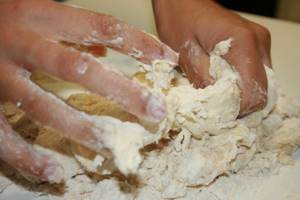
If you want to get sweeter baked goods, then you can add a little granulated sugar or honey to the dough.
Modern baking recipes without yeast
Modern housewives often choose Irish soda bread for their first experiments in cooking themselves. Which is understandable, since the baking process does not require infusion and long kneading of the dough. It is enough to mix all the ingredients with a spoon and knead with your hands several times.
There are now many recipes for Irish cakes. Over time, they changed and adapted to modern life. There are a lot of multicooker recipes that are now gaining popularity. Let's look at one of these.
To bake the product you will need the following ingredients:
- a couple of glasses of coarsely ground flour;
- one large spoon of oat flakes;
- a teaspoon of sugar, salt in the same amount;
- fifty grams of butter;
- a small glass of kefir;
- baking soda no more than one and a half teaspoons;
- If desired, you can add seeds, nuts or dried fruits.
Initially, you need to mix the bulk ingredients in a deep bowl. Softened butter is added. After this, pour in kefir and knead. You should get a soft dough.
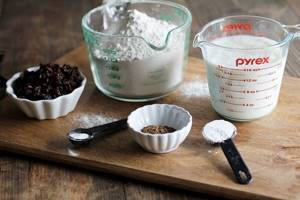
The Irish sometimes add a handful of caraway seeds or raisins to their soda bread.
Pour the resulting mixture into the multicooker container, which must first be greased with butter. It is necessary to cook for half an hour by selecting the “Baking” mode. To prevent the product from becoming dry, after cooking it can be greased with a piece of butter and wrapped in a towel.
No less popular among housewives is soda bread, the recipe for which includes currants. For it you need to mix three glasses of sifted flour and an incomplete glass of sugar. Add to them one teaspoon of salt, soda, and three level spoons of baking powder. Beat two eggs separately and mix them with two tablespoons of melted butter. You need to pour this mixture into the flour, add a glass of kefir, currants and knead. The dough should be the same thickness as for a sponge cake.
You need to bake this cake in the oven at a temperature of one hundred and eighty degrees for an hour.
After cooking, do not immediately remove the product from the mold. Let it cool.
Useful information about homemade yeast-free bread
Now you know how you can bake delicious and aromatic bread yourself without using baker's yeast. It should be noted that such a product has a number of useful properties. Among them the following can be noted:
- Homemade bread made without yeast contains an incredible amount of minerals and vitamins.
- Yeast-free bread, made from wholemeal flour, is a self-sufficient and balanced product. Thanks to its unique composition, it helps to reduce excess weight, as well as normalize the functioning of the digestive tract and the entire body as a whole.
- Microbiologists say that regular consumption of homemade yeast-free bread significantly strengthens the immune system and also promotes the formation of healthy cells, preventing the formation of various tumors.
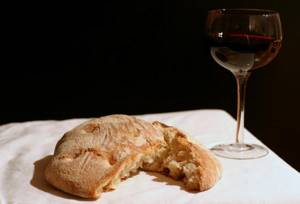
Among other things, one cannot help but say that bread prepared without the use of yeast can be stored for quite a long time without losing its taste and beneficial properties. It is this fact that encourages many housewives to make baked goods at home, rather than purchase them in a store.
A little history
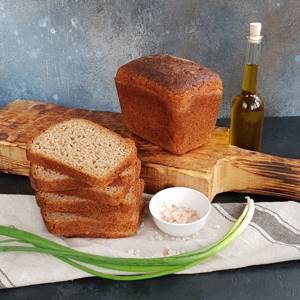
Many thousands of years ago, people learned to prepare a yeast-free product from flour and water, baking it on stones heated under the sun. This tradition has not sunk into the past: it is in this way, without using sourdough and yeast, that Armenian and Persian lavash, Jewish matzo, Mexican tortilla, Italian focaccia, Indian chapati and the notorious Russian flatbread are obtained.
In the old days, bread was always prepared with sourdough. Each component was vegetable, it provoked fermentation. The most famous peasant starters contained hops, raisins, honey and malt were added here. Rye flour, barley, and wheat were often used.
It was a valuable source of vitamins and enzymes. As a result, consuming such a product, a person became more energetic, and the body’s immune forces were stimulated.
Until the 12th century, white bread was most often prepared in Rus'. And the rye product with sourdough began to be baked a little later. From ancient monastery chronicles it is known that in addition to white bread, they also baked rye bread. There are known recipes for sourdough bread that came to us from monasteries in the 19th century. This is a natural product that definitely does not contain any harmful additives.
